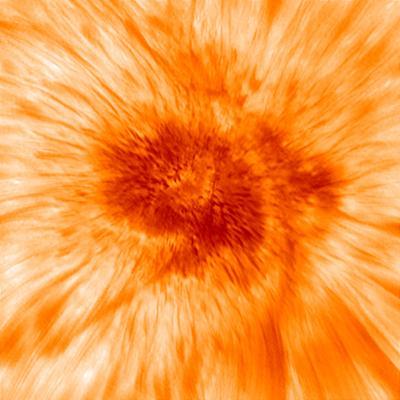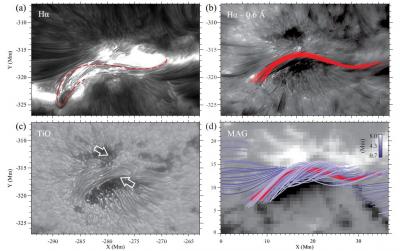.

Scientists at NJIT's Big Bear Solar Observatory (BBS)) have captured the first high-resolution images of magnetic fields and plasma flows originating deep below the Sun's surface, tracing the evolution of sunspots and magnetic flux ropes through the chromosphere before their dramatic appearance in the corona as flaring loops.
The images, observed through NJIT's 1.6 meter New Solar Telescope, provide an unprecedented glimpse into the complex dynamics of the Sun’s multi-layered atmosphere as well as insights into the massive eruptions on the Sun’s surface responsible for space weather.
Haimin Wang, distinguished professor of physics at NJIT, recently published images of the flaring magnetic structures known as solar flux ropes at their point of origin in the Sun’s chromosphere. Bundles of magnetic fields that together rotate and twist around a common axis, flux ropes are driven by motions in the photosphere, a high-density layer of the Sun’s atmosphere below the corona and chromosphere.
“These twisting magnetic loops have been much studied in the Sun's corona, or outer layer, but these are the first high-resolution images of their origination in the chromosphere below it. For the first time, we can see their twisting motion in great detail and watch how it evolves,” said Wang, the lead author of a recent study published in Nature Communications.
Wang and his co-authors strung together a series of images which trace the formation of an S-shaped bundle of magnetic fields from which a set of loops peel off and grow upward into a multi-strand flux rope within minutes. Two flare ribbons appear at the two sides of the rising flux rope. The images provide unprecedented detail, as well as powerful new clues about their initiation and their relationship to solar eruptions and coronal mass ejections.
Energy releases in solar flares and associated forms of eruptions occur when magnetic field lines, with their powerful underlying electric currents, are twisted beyond a critical point that can be measured by the number of turns in the twist. The largest of these eruptions cause what is known as space weather – the radiation, energetic particles and magnetic field releases from the Sun powerful enough to cause severe effects in Earth’s near environment, such as the disruption of communications, power lines and navigation systems.
.

“One of the exciting things about these new images is that we can now distinguish between mild twists and those severe enough to cause space weather,” said Wang, who likened the eruptions to earthquakes, which are energy releases following the build-up of tension as tectonic plates rub against each other along fault lines. The team is developing tools to predict space weather from solar observations and modeling.
Unveiling the Complex Dynamics of Sunspots’ Dark Cores
Another recent set of images captured at the Big Bear observatory give a first-ever detailed view of the interior structure of umbrae – the dark patches in the center of sunspots – revealing dynamic magnetic fields responsible for the plumes of plasma that emerge as bright dots interrupting their darkness. The high-resolution images show the atmosphere above the umbrae to be finely structured, consisting of hot plasma intermixed with cool plasma jets as wide as 100 kilometers.
“We would describe these plasma flows as oscillating cool jets piercing the hot atmosphere. Until now, we didn’t know they existed. While we have known for a long time that sunspots oscillate – moderate resolution telescopes show us dark shadows, or penumbral waves, moving across the umbra toward the edge of a sunspot – we can now begin to understand the underlying dynamics,” said Vasyl Yurchyshyn, a research professor of physics at NJIT and the lead author of two recent journal articles published in the Astrophysical Journal.
Called spikes, the oscillating jets result from the penetration of magnetic and plasma waves from the Sun’s photosphere – the light-giving layer of its atmosphere – into the abutting chromosphere, which they reach by traveling outward along magnetic tubes that serve as energy conduits. “This process can be likened to a blowhole at a rocky beach, where relentless onshore waves jet sea water high into the air,” said Yurchyshyn, who recently presented his research at the first Triennial Earth-Sun Summit meeting between the American Astronomical Society’s Solar Physics Division and the American Geophysical Union’s Space Physics and Aeronomy section in Indianapolis, Ind.
Sunspots are formed when strong magnetic fields rise up from the convection zone, a region beneath the photosphere that transfers energy from the interior of the Sun to its surface. At the surface, the magnetic fields concentrate into bundles, which prevent the hot rising plasma from reaching the surface. This energy deficit causes the magnetic bundles to cool down to temperatures about 1,000 degrees lower than their surroundings. They therefore appear darker against the hotter, brighter background.
“But the magnetic field is not a monolith and there are openings in the umbra from which plasma bursts out as lava does from a volcano’s side vents. These plumes create the bright, nearly circular patches we call umbral dots,” Yurchyshyn noted. “Sunspots that are very dark have strong magnetic fields and thus fewer openings.”
Compact groups of fast-changing sunspots create tension in their magnetic systems, which at some point erupt to relieve the stress, causing space weather events in the Earth’s magnetosphere.
“We had no sense of what happens inside an umbra until we were able to see it in the high-resolution images obtained with the world’s largest solar telescope. These data revealed to us unprecedented details of small-scale dynamics that appear to be similar in nature to what we see in other parts of the Sun,” Yurchyshyn said. “There is growing evidence that these dynamic events are responsible for the heating of coronal loops, seen in ultraviolet images as bright magnetic structures that jet out from the Sun’s surface. This is a solar puzzle we have yet to solve.”
Probing Sunspot Oscillations
Through NST observations, scientists are also able to measure the shape of chromospheric spectral lines, enabling them to probe solar conditions.
“These measurements tell us about the speed, temperature, and pressure of the plasma elements we are observing, as well as the strength and the direction of the solar magnetic fields,” said Yurchyshyn, who is also a distinguished scholar at the Korea Astronomy and Space Science Institute. “Thus we were able to find that spikes, or oscillating jets, are caused by chromospheric shocks, which are abrupt fluctuations in the magnetic field and plasma that constantly push plasma up along nearly the same magnetic channels.”
In a second paper published in the Astrophysical Journal, Yurchyshyn and his co-authors give a closer view of sunspot oscillations that occur every three minutes and are thought to produce bright umbral flashes - emissions of plasma heated by shock waves.
The NST takes snapshots of the Sun every 10 seconds, which are then strung together as a video to reveal fast-evolving small explosions, plasma flows and the movement of magnetic fields. “We were able to obtain photographs of these flashes of unique clarity that allowed us to follow their development inside the umbra,” he said, noting that while the diffuse patches were once believed to be randomly distributed, the NST images show them mainly forming along so-called sunspot umbral light bridges, which are very large openings in the sunspot magnetic fields that often split an umbra into two or more parts.
Quelle: New Jersey Institute of Technology / University Heights Newark, New Jersey
4216 Views
